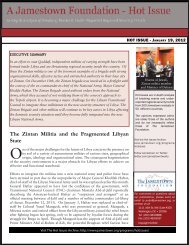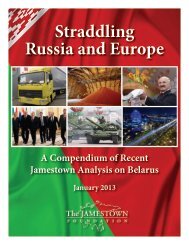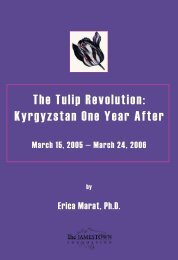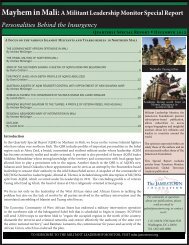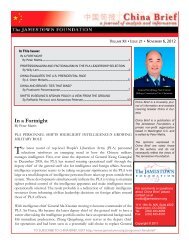By Brian Glyn Williams - The Jamestown Foundation
By Brian Glyn Williams - The Jamestown Foundation
By Brian Glyn Williams - The Jamestown Foundation
Create successful ePaper yourself
Turn your PDF publications into a flip-book with our unique Google optimized e-Paper software.
Crimean Khan, Selim Giray, to once again ravage Podolia. Selim Giray's forces also aided the Ottomans in<br />
their successful siege of Kamenetz, the provincial capital of Podolia. After the capital's fall, the Khan raided<br />
deeper into Poland capturing more than a thousand captives according to Howorth. 90<br />
<strong>The</strong> war continued with varying successes until the year 1676 when the Polish government finally<br />
bowed before the Ottomans' military supremacy and signed the humiliating Treaty of Buzacz. This<br />
treaty brought the Ukraine under Ottoman suzerainty and Podolia under direct Ottoman control.<br />
<strong>The</strong> treaty did not, however, bring lasting peace and, in the following years, the Tatars were<br />
called upon to defend the Empire's gains on several occasions. <strong>The</strong> rise to power of one of Poland's<br />
greatest warriors, Jan Sobieski, in the years following the Treaty of 1676 did not make the Tatars' task any<br />
easier.<br />
Davies' description of Sobieski shows that the Poles had finally found a leader who understood the Tatars and<br />
could beat them at their own game.<br />
He was born in a thunderstorm during a Tartar raid. His maternal grandfather, Hetman<br />
Zolkiewski, and his brother, were both beheaded on the battlefield by Tartars; and his<br />
uncle, Stanislaw Danillowicz, died in Tartar captivity. He could not but be profoundly<br />
affected by the family, and its inscription: O quam est pro patria mori. In 1653, he<br />
voluntarily submitted himself as a hostage in Bakchisaray; in 1654, he was in Istanbul; in<br />
1657, he commanded the Republic's Tartar auxiliaries. No one was more experienced in,<br />
or fascinated by the ways of the East than he. 91<br />
One of Sobieski's greatest achievements was the creation of a highly mobile army that could catch and<br />
destroy the fast moving Tatar chambuls (raiding parties). One has but to look at his many victories<br />
over the Crimean Tatars to understand how the King was able to gain the respect of his Tatar<br />
adversaries. Sobieski was known for making lightning strikes of distances of over 150 miles in Tatar fashion.<br />
One of his more notable successes occurred in 1675. Sobieski was able to move against a Tatar force of<br />
20,000 riders with only 5,000 men and inflict a costly defeat on an enemy that had only a few years earlier<br />
been considered almost invincible. 92<br />
<strong>The</strong> King's outstanding successes against the Tatars undoubtedly left an impression on the Khanate's<br />
leaders and may have influenced Murad Giray in his decision to flee before the Poles during the famous<br />
Ottoman siege of Vienna in 1683. <strong>The</strong> following description of the Polish attack on the besieging<br />
Ottoman army from Sobieski's letters tends to lend credence to this theory:<br />
It is said that when the Vizier realized he could not hold out against us, he called his two<br />
sons to him, and having embraced them, exclaimed in tears to the Tatar Khan, 'Save me if<br />
you can.' But the Khan replied, 'We know the King of Poland well. He is irresistible. Let<br />
us consider rather how best to escape.' 93<br />
Although the Tatars were able to assist the Ottomans against the Poles as late as 1687, their ability to<br />
strike at Polish targets with impunity had come to an end. Sobiesksi’s reforms on Poland's eastern<br />
border succeeded in bringing this exposed area under Polish control by the end of the seventeenth century.<br />
<strong>The</strong> Ottomans may have been equally influential in bringing the Tatar's raids to halt in these years for they<br />
had begun to consider the maintenance of a strong Poland as a counter weight to Russian expansion as<br />
24






